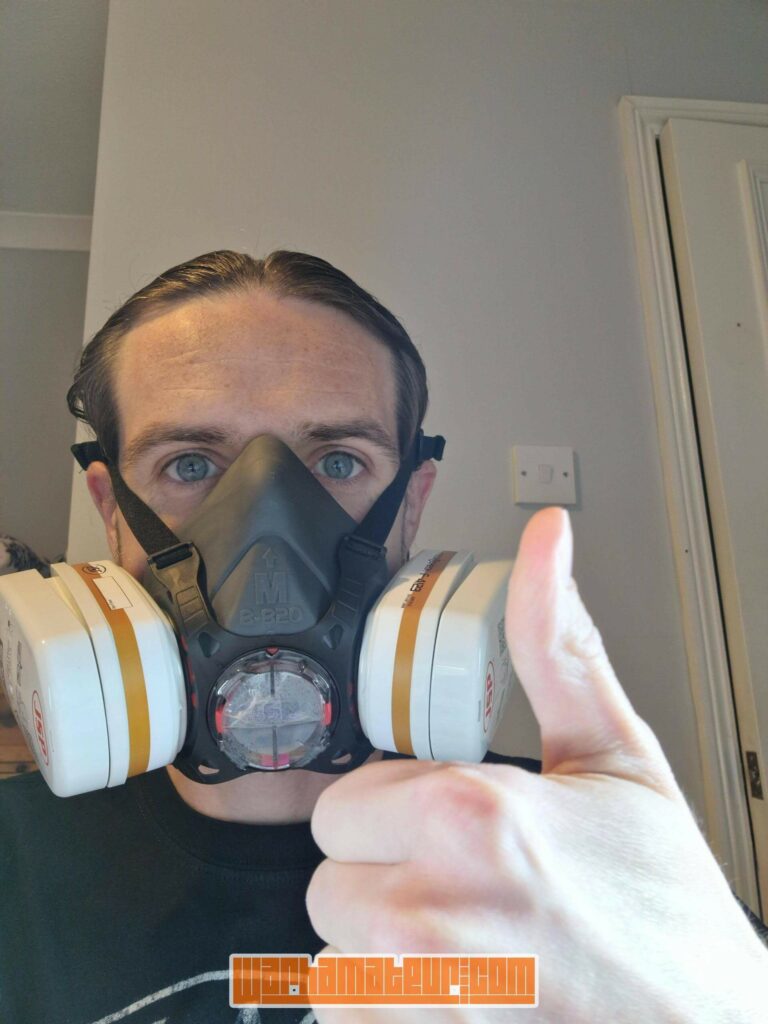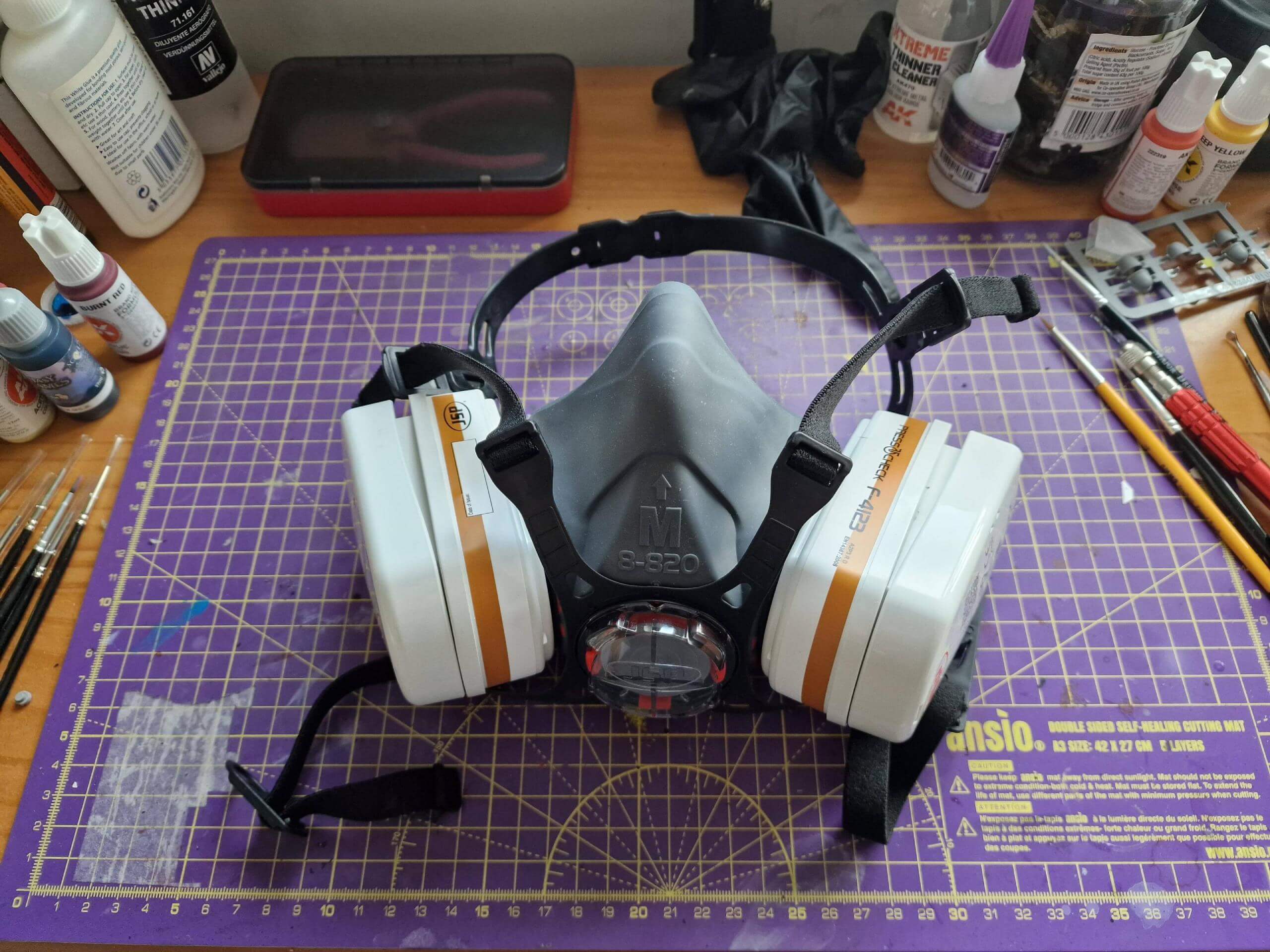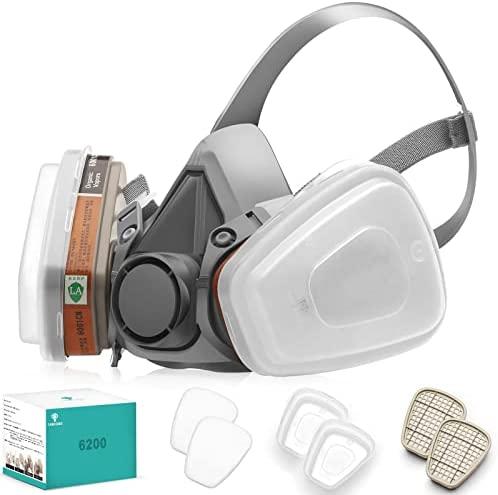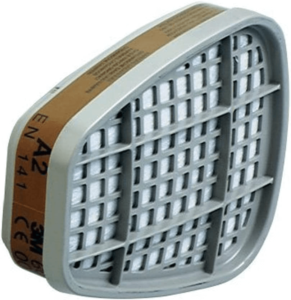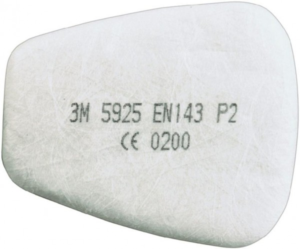While writing my Dirty Down Rust review I reached out to Magos Terra for some advice regarding the type of airbrush respirator I would need for spraying solvent-based paints. When he responded he gave me that much information that there was no choice but to turn it into what I think is a rather definitive guide!
So I’m going to hand over the reins to MT for our first proper guest post – take it away!
Sooo let’s talk about respirators!
Materials
The first thing you have to do is know what type of materials you are dealing with. The important types for our hobby are:
- organic solvents / vapours
- inorganic solvents / vapours
- dust
- aerosols
(I’ll leave out acid gasses, ammonia, etc as those aren’t really important in our hobby if you don’t mess up massively! 😂)
There are dedicated filters for organic vapours, inorganic vapours and dust. I’ll comment on aerosols later.
So how are those present in our hobby?
Organic vapours
This is the category that encompasses the vapours given off by carbon-based (organic) solvents. Almost every time we have something solvent-based in our hobby it’s an organic solvent. Examples are: Acetone (paint remover), Ethanol (varnishes, lacquer paints), Toluene (acrylic paints).
So what does breathing in those vapours do to you? Well this is heavily dependent on which organic compound we are talking about. Some are less toxic than others, and of course the concentration and amount also plays a big role. (did you know that once it enters the body isopropanol will be metabolised into acetone? Fun stuff!)
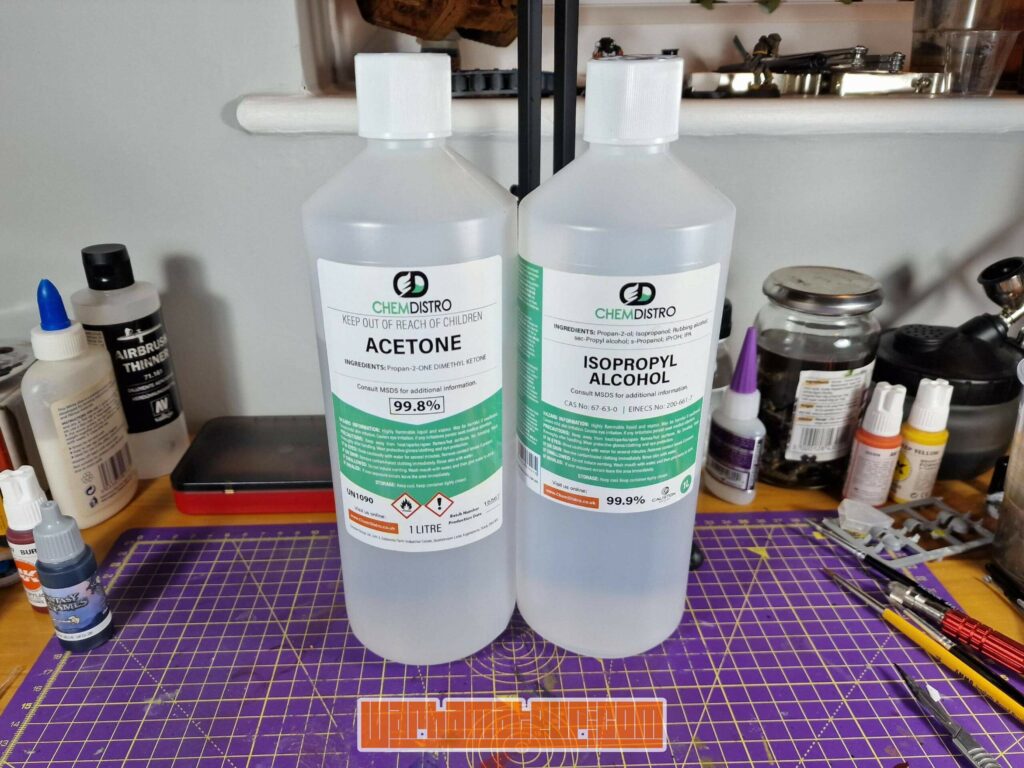
We can however make some generalisations about the effects of breathing in organic vapours.
Short term effects are usually headaches, nausea, feeling drunk, drowsiness, irritation of eyes, nose, skin, throat.
Long term effects include memory problems, tiredness, concentration difficulties, mood changes.
Inorganic vapours
Short explanation: everything that’s not an organic vapour. And yes, that’s a pretty broad range of substances, including water. That’s why the bad stuff is usually put under the term inorganic nonaqueous solvents, AKA all inorganic solvents that aren’t water. Or if you want “every solvent that’s neither organic nor water”.
This is the area where we enter the territory of really spicy air! Such fun things as Sulphuric Acid, Hydrogen Cyanide, Hydrogen Sulphide. All the things you don’t even want to take a whiff of (because in general: it’ll kill you in seconds).
We don’t have stuff like this in our hobby. And if you do, you should really start to worry!
Dust
Dust is, again, a rather broad range of substances. Especially as basically everything can be turned into dust (if it’s not a liquid or gas of course). Dust can be dangerous in several ways. For one it can irritate your eyes. Not fun, but as long as the dust particles aren’t damaging the eyes (some metal dust takes the form of small razor sharp slivers. Avoid this.) it’s mostly just a nuisance.
The big danger is breathing it in. Some types of materials (inorganic dust) can’t be broken down by the body and accumulate in the respiratory system thus leading to Pneumoconiosis and other nasty conditions where the lungs get physically damaged by the accumulated particles. But, luckily for us, this usually takes years of exposure to fine inorganic dusts. It’s an occupational disease often connected to work in mines, sandblasting and agriculture.
Now to the part that’s important for our hobby. Organic dust can be broken down by the body. Sounds neat at first as it prevents accumulation of particles in the lungs. But there is a big problem. Broken down also means entering the bloodstream. While our body is pretty good at filtering out stuff that’s bad for it, some of the materials are extra bad. Cancer-level bad.
Avoiding carcinogens
Carcinogenic dust examples:
- leather
- rubber
- some plastics
- resin
A quick tour on what carcinogenic means:
Regular toxicity is actually pretty chill if you think about it. You have specific levels at which substances become toxic. If you stay below those levels all is good (mostly). This also means if you stay within the workspace limits given in the Materials Safety Data Sheet (MSDS) you are safe.
Carcinogenic substances are different.
Carcinogenicity isn’t determined by a threshold, instead it’s probabilistic. This means even a single short exposure to a small amount of carcinogenic particles can lead to cancer, however the probability is very low. It rises with repeated or prolonged exposure though. So in the case of carcinogenic materials it’s always advisable to use appropriate protection. That’s why we wear particle masks when sanding resin miniatures.
Aerosols
What dust is to solids, aerosols are to liquids; small airborne droplets. Take everything I said about organic solvents and add what you now know about dust. Breathing in an aerosol means the solvent droplets then get absorbed into the bloodstream via the lungs. This leads to much higher concentrations of the material in question.
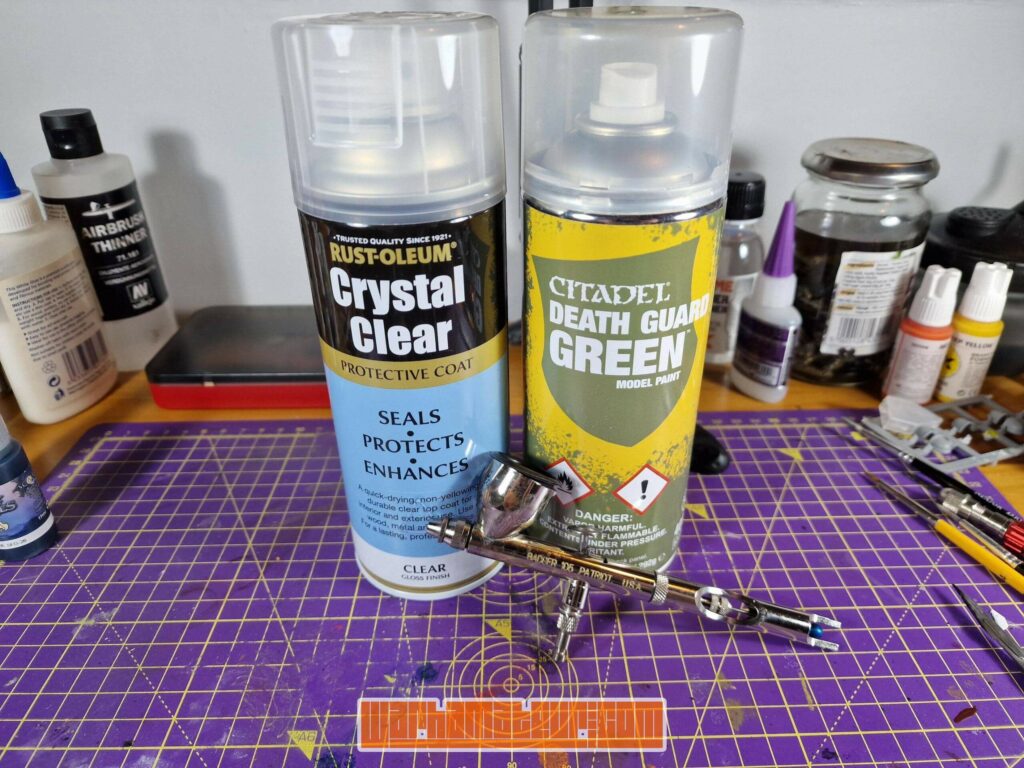
So what type of respirator do I need?
This depends on what you are working with and what the level of exposure is. Working with enamel paints/washes out of the pot and applying them with brushes only exposes you to organic vapours. As we are usually working with small quantities over short periods of time (compared to a work related exposure; that’s what materials are usually rated by) all you need to do is to provide good ventilation. And to avoid ingestion, but I think that was clear from the get-go.
But airbrushing those same paints creates an aerosol, thus exposing you to much larger amounts and concentrations of the substance. This means a respirator should be mandatory! And it must not only protect against the aerosol but also the vapours given off by the droplets, as they will still gas out after being caught by the particle filter. On top of that the process of vaporising the paint causes it to be more volatile, so you have to expect larger amounts of vapour anyways.
Airbrushing low-toxicity (I am very careful with the term non-toxic) acrylics should only require protection against aerosols, but if you are not sure about the toxicity always go for the safer approach.
Okay now after all my rambling some concrete answers to the initial question.
Filter grading
Filters are graded by what they filter. And surprise, they are rated by the exact same categories we just talked about!
A -> Organic Vapours
B -> Inorganic Vapours
E -> Acid gasses
K -> Ammonia
P -> Particles
As you can see the highlighted ones are the important filter types for our hobby. A to protect against organic vapours and P to protect against particles and aerosols.
These letters are then combined with numbers that indicate how good the filter is at filtering the substance in question – 1 being the worst and 3 being the best. (during the pandemic you probably have heard about FFP2 and FFP3 masks. Now you know what the P2 and P3 are standing for 😉)
Most filters aren’t even available in 1. 2 is sufficient for most cases. And with that I mean every case that doesn’t involve constant exposure over a prolonged period.
So 2 is what we want. If you find something better, go for it.
And now the final final answer to the question 😄
You want to look for respirators that are graded with A2P2 (or 3).
How do I know if a filter is A2P2?
Sometimes it’s easy and the seller provides the exact filter type in the item description, but sometimes the descriptions are either incomplete or missing entirely.
I’ll show you the filter markings using a 3M 6300 half mask as an example.
All filters have a coloured band placed around them. The colour indicates the filter type. This is a marking that’s universally existent on every type of filter, no matter the context. Firefighting, civil protection, military. Everywhere.

Some companies also print the filter type on top of the coloured stripe. 3M does this. So the filter looks like this:
Brown banding and A2. That’s what we are looking for!
So that’s the vapour part done. Now onto the particles. 3M provides insertable particle filter pads.
In the end the combination looks like this:
Such a combination can cost around €70. In the end though it’s about your health and safety – not an area where you should save money (I will judge you if you say otherwise!)
Finding your airbrush respirator
Now that the good Magos has taught us how to find what we need, I’m back to look at a couple of mask examples.
You’ve seen photos above of a 3M half mask – 3M are considered to be one of the go-to companies for safety equipment, and you can find a mask similar to the above for a little over £20. You then need your A2 filters (around £20) and P2 pads (around £20 again) for an overall cost of around £60-65, which is about what Magos Terra expected.
I personally have been using a JSP Force 8 mask with A2P3 filters, at a combined cost of around £30. I’ve sprayed plenty of nasty stuff about while wearing this and I can still breathe, so I reckon it’s doing an alright job! 😉
Another alternative is this A2P3 mask from Dräger, which comes in at around £35.
Whichever mask you choose, make sure you test it before using it! Some masks offer multiple sizes and ensuring that you have a good, airtight fit is essential! The JSP mask I use has a ‘Press to Check’ system, but simply covering the filters on your mask and breathing in should cause a vacuum inside the mask itself. If you don’t have this vacuum then you don’t have a perfect seal, and your mask can’t protect you from the vapours or particles that sneak around the filters!
So there we have it! I’d like to thank Magos Terra again for offering to share his knowledge, and hopefully we’ll be seeing more of his insights in the future! 🙂
